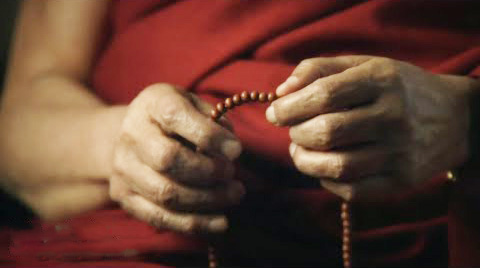
On The Buddhist Rosary or Mala
by Lama Jigme Rinpoche
There is a difference between ordinary people and Dharma practitioners. Ordinary people are used to living life with weapons and guns while Dharma practitioners show compassion, recite mantras and meditate. With guns, knives or weapons you cannot defeat your enemies. There is a saying, “As soon as you get rid of one enemy, there is already another one coming.” This type of behavior with enjoying weapons reflects the condition of that type of mind.
If you are a Dharma practitioner and you carry a mala around your neck and recite mantras, you have already defeated your enemies. Enemies do not exist on the outside, but inside your own mind.
Many Tibetan and Chinese people are used to carrying a rosary in their hands; their minds rely on their rosary. Keeping the rosary around the wrist or neck reminds us to cultivate a compassionate mind. It is the instrument for compassion and reminds us of the suffering of all sentient beings. This is the first meaning of carrying a mala.
Secondly, after having recite the mantras of the Highest Yoga Tantra, and blowing on it for its blessings, it will protect us from diseases, obstacles and will help us accomplish the mind of the Yidam. The rosary becomes the ornament of the Yidam.
Thirdly, when we use the rosary to recite mantras, the thumb symbolizes ignorance, the index finger symbolizes hatred and the other three fingers are like the wing of a bird, symbolizing attachment and desire.
With these three symbols, we should recite the mantras of the Highest Yoga Tantra.
Also fourthly, the Buddhist Mala has one hundred and eight beads. With each rosary we accumulate one hundred mantras and we additionally recite eight more, in case we missed any out of those one hundred.
There is a story that sometime on this Earth, people were suffering from a terrible disease caused by Nagas and other harmful spirits. This made humans make prayers to the gods for help. One-hundred and eight gods came to Earth from their realm and cured all the diseases. The one-hundred and eight beads of the mala reminds us of these gods.
After having blessed your mala, the mala becomes a protection and a reminder for compassion. The Tibetan traditional shirt has three buttons. We should hold the mala close to our chest, as if it were one of these buttons. Its movement should be not so quick and not so slow, this is how to hold a mala.
The mala with which we recite with should not be touched by anyone.
There are four different colors for four different energies of deities:
– Peaceful: white (glass, wood, pearls)
– Serious: gold, yellow (Sandalwood, Bodhi seed, ivory, silver and gold)
– Empowerment: red (Rudraksha, skulls)
– Wrathful: blue (Rudraksha, skulls)
When reciting a mantra, one should know the profound meaning from your heart as you pronounce it. Your mala should not be placed in anybody else’s hand, or should it be put on the ground nor should you step on it or over it. You should visualize your body as the extraordinary body or Vajra Body and your mind should hold the View of the Yidam.
The mala should be perfectly suited for the mantra one recites. The string of the rosary should also be perfect for the type of mantra.
One should not purchase malas from hunters, cheaters or liars, but from good hearted people only.
The mala is all blessings together in one, it is the only blessing, it represents everything. For this reason, it should not be touched by anyone.
It is not necessary to have an expensive or luxurious mala, but it is important to have the right characteristics for the mala.
It is also not good to allow people to see your mala when one is in retreat or when reciting the innermost secret mantras.
This is just a brief explanation of the numerous meanings of the Buddhist rosary.
As taught by the Venerable Lama Jigme Namgyal Rinpoche on November 15, 2011.
